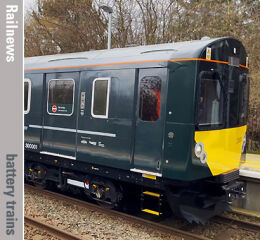Posted 9th February 2024 | No Comments
GWR battery train test runs to start this spring

The long-running battery train project on Great Western Railway is set to move forward this spring, when trial operation begins on a branch line in west London.
GWR took over the development of battery units based on former London Underground trains when their innovator Vivarail went into administration at the end of 2022.
Vivarail had been demonstrating the converted units for several years at its Warwickshire site. When the company failed GWR bought rolling stock and test equipment, and also employed some specialist staff who had been working at Vivarail.
The tests on the Greenford branch will involve a short length of conductor rail at West Ealing station which is used to charge the batteries and is only live when a train is over it.
The technology is dubbed FastCharge, because only 3.5 minutes is needed to recharge the batteries with up to 2000kW.
Conductor rails and lineside battery banks have been installed at West Ealing in preparation for the start of the trials, which will not include operation in public service for now.
GWR engineering director Dr Simon Green said: ‘This work has never been done before and we’re leading the way to help the Department for Transport and Network Rail understand what is required to roll out this technology.
‘Only now has there been a combination of battery capability and charging technology that enables a branch line train to operate to the same timetable as a diesel unit, and yet still charge safely and with minimal impact on the local grid power supply.
‘Our specialist engineering team have been working round-the-clock to ensure that this FastCharge system has been fully tested and that there will be sufficient charge for the train to operate to the timetable on the Greenford branch.
‘Each branch line will vary but this is an incredibly exciting innovation and I’m proud that GWR is at the forefront of the railway’s commitment to phase out diesel-only traction by 2040.’
Battery powered trains have been tried out from time to time ever since the nineteenth century, and British Railways experimented with the technology on the Ballater branch in Scotland between 1958 and 1966, using lead acid batteries.
More recently, passengers were carried for several weeks on the Manningtree to Harwich Town line in Essex in early 2015, using an adapted Bombardier Class 379 unit. The branch is electrified, and the experimental unit recharged its battery rafts from the 25kV overhead.
Battery trains supplied by Stadler last year are being used on Merseyrail, to bridge the non-electrified section between Kirkby and the new station at Headbolt Lane.
